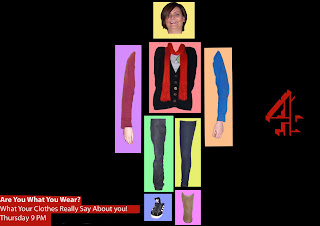
A2 MEDIA COURSEWORK
Wednesday, 5 January 2011
Tuesday, 4 January 2011
Evaluation: Q1- In what ways does your media product use, develop or challenge forms and conventions of real media products?
Documentary
The picture below shows the framing and graphics in our documentary and also the picture below that also shows the framing and graphics in a real documentary and this shows how we have followed the codes and conventions throughout our documentary. You can also see that the graphics we have used are simple and in white writing which makes it clear for the audience to read and follow.
This is a voice recording of the script above.
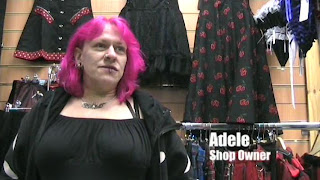
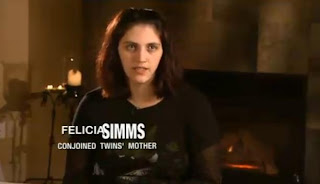
This picture shows a police officer being interviewed by me. Due to Bob Murray being in the police force, the framing shows the key aspects of him being a policeman such as him wearing his uniform and also the police van in the background.
This is a vocie recording of the script above.
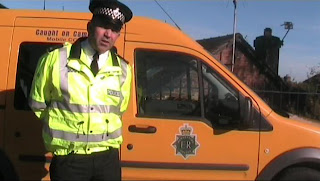
This image shows a cutaway that we used during our documentary when Mrs P Battle was talking about hoodies and having a negative affect.
This is a voice recording of the script above.
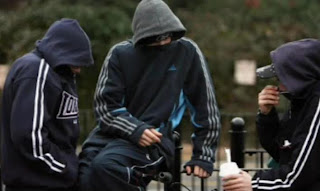
Here is a cutaway that is used throughout a real documentary and the cutaway shows what the voiceoever is talking about. The interviewee here was talking about engagement outfits for gypsy weddings.
Here is a voice recording of the script above.
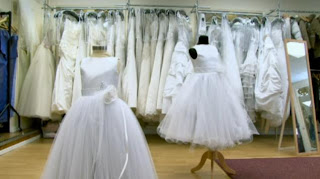
Here this picture shows some archive material that we used during our documentary.
Here is a voice recording about the two archive images below.
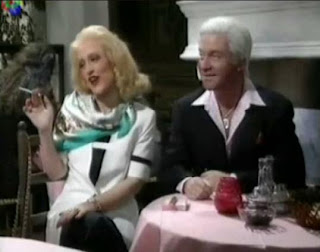
And this is a picture of archive footage being using during: The Twins that share a brain.
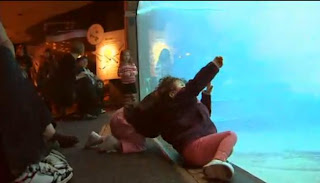
END OF QUESTION 1
Here is a voice reecording of the script below
Editing- After filming all the footage for our documentary including itnerviews and cutaways we had to edit out things so that we could follow the codes and conventions of a real media product, for example during interviews we edited out the questions asked by the itnerviewer so you would not hear them in the final draft.
Voiceover- We used a male voiceover with no accent and a clear voice as this would be easy for the audience to understand. We needed a voice narration that would set the mood for the documentary and that had an interesting tone. This is also following the codes and conventions as real media products use a clear voiceover etc.
Use of music- In our documentary we used music that we thought would fit in. For example when a cutaway was used of a little girl looking at dresses and shopping it gave a magical affect, so we decided to use the theme music from disney.
Print advert
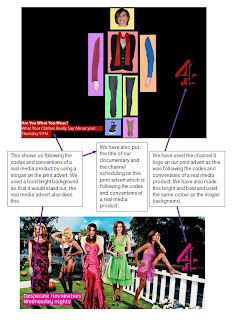
Click to enlarge
Radio trailer
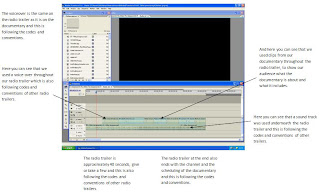
Click to enlarge
The picture below shows the framing and graphics in our documentary and also the picture below that also shows the framing and graphics in a real documentary and this shows how we have followed the codes and conventions throughout our documentary. You can also see that the graphics we have used are simple and in white writing which makes it clear for the audience to read and follow.
This is a voice recording of the script above.


This picture shows a police officer being interviewed by me. Due to Bob Murray being in the police force, the framing shows the key aspects of him being a policeman such as him wearing his uniform and also the police van in the background.
This is a vocie recording of the script above.

This image shows a cutaway that we used during our documentary when Mrs P Battle was talking about hoodies and having a negative affect.
This is a voice recording of the script above.

Here is a cutaway that is used throughout a real documentary and the cutaway shows what the voiceoever is talking about. The interviewee here was talking about engagement outfits for gypsy weddings.
Here is a voice recording of the script above.

Here this picture shows some archive material that we used during our documentary.
Here is a voice recording about the two archive images below.

And this is a picture of archive footage being using during: The Twins that share a brain.

END OF QUESTION 1
Here is a voice reecording of the script below
Editing- After filming all the footage for our documentary including itnerviews and cutaways we had to edit out things so that we could follow the codes and conventions of a real media product, for example during interviews we edited out the questions asked by the itnerviewer so you would not hear them in the final draft.
Voiceover- We used a male voiceover with no accent and a clear voice as this would be easy for the audience to understand. We needed a voice narration that would set the mood for the documentary and that had an interesting tone. This is also following the codes and conventions as real media products use a clear voiceover etc.
Use of music- In our documentary we used music that we thought would fit in. For example when a cutaway was used of a little girl looking at dresses and shopping it gave a magical affect, so we decided to use the theme music from disney.
Print advert

Click to enlarge
Radio trailer

Click to enlarge
Monday, 3 January 2011
Evaluation- Q2: How effective is the combination of your main product and ancillary texts?
We used similar slogans in our documentary and our radio trailer so that they would link together and form a relationship. Our slogan used on our print ad is ‘What your clothes really say about you’ and this would draw in the audience because they want to know what clothes say about them. Our title ‘Are you what you wear?’ is used on all three products and this links them all together.
Here is a voice recording of the script above.

This is a voice recording of the script below.
Key image- The image we used on the print ad shows different items of clothing and body parts. For example we used someone’s head, somebody else’s arm, somebody else’s shoe, etc. This connotes people wearing different clothing and connoting ‘are you what you wear?’.
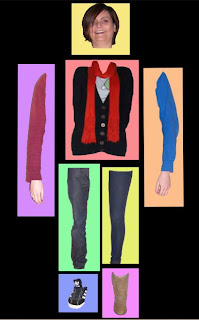
Below is a montage of all the images we used to create our print advert.
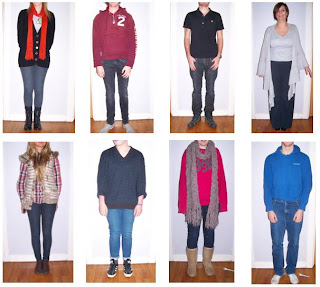
This is a recording of the script below.
The voiceover is used during the documentary and the radio ad. We decided on this as it links the two together. We chose to use a male voiceover which was clear and understanding with not much accent so the audience could understand clearly.
Also on the print ad, where our title, slogan and scheduling is shown we have used a red background, we also used this colour red behind the channel 4 logo so that they would link together the documentary and the channel.
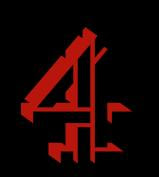
This is a recording of the script below.
The music used at the beginning of the documentary is also used on the radio ad, and we chose to do this so both would link together. We chose to use Scissor Sisters – Filthy/Gorgeous as it was very upbeat and really went well with our title sequence. Also at the beginning the word ‘gorgeous’ is used and this could relate to what your clothes are saying about you by being ‘gorgeous’.
Here is a recording of the script below.
Channel and Scheduling
We have used the channel and scheduling on all of our tasks. Similar documentaries are shown at this time on this channel and this is good for our documentary as we will attract the audience of those documentaries.
Channel 4 has many audiences and one of them audiences is similar to the audience that our documentary is targeted at.
This is a recording of the script below.
Advertising
To advertise our documentary, a print ad and a radio trailer was created. Below is a montage of where our documentary would be advertised.

This is a recording of the script below
We will also have our radio advert advertised on selective local radio stations, but also for DAB radio listeners as we will attract a wider range of our target audience from all over the country.
Our radio advert will be scheduled for different times during the day. Appropriate times for our documentary to be advertised would probably be prime time, for example 7am – 10am as people would be listening on their way to work, people on their way to school/college/university etc and this could attract a large audience between these times. Another time of day which is quite popular on the radio is lunchtime being 12pm-2am as people would be on lunch breaks or the radio could be on throughout the working day. And finally the last popular time on the radio would be from 4pm-7pm as this would be the ‘drive time’ show as people will be coming back from work and sometimes tune in to the radio, or being at home and listening at home. DAB listeners could be listening via their TV or internet around these times too.
The print ad could be advertised on which ever day of the week as different people read different newspapers on different days. But it would be compulsory that the print ad was in all newspapers the day it was being screened on TV.
Here is a voice recording of the script above.

This is a voice recording of the script below.
Key image- The image we used on the print ad shows different items of clothing and body parts. For example we used someone’s head, somebody else’s arm, somebody else’s shoe, etc. This connotes people wearing different clothing and connoting ‘are you what you wear?’.

Below is a montage of all the images we used to create our print advert.

This is a recording of the script below.
The voiceover is used during the documentary and the radio ad. We decided on this as it links the two together. We chose to use a male voiceover which was clear and understanding with not much accent so the audience could understand clearly.
Also on the print ad, where our title, slogan and scheduling is shown we have used a red background, we also used this colour red behind the channel 4 logo so that they would link together the documentary and the channel.

This is a recording of the script below.
The music used at the beginning of the documentary is also used on the radio ad, and we chose to do this so both would link together. We chose to use Scissor Sisters – Filthy/Gorgeous as it was very upbeat and really went well with our title sequence. Also at the beginning the word ‘gorgeous’ is used and this could relate to what your clothes are saying about you by being ‘gorgeous’.
Here is a recording of the script below.
Channel and Scheduling
We have used the channel and scheduling on all of our tasks. Similar documentaries are shown at this time on this channel and this is good for our documentary as we will attract the audience of those documentaries.
Channel 4 has many audiences and one of them audiences is similar to the audience that our documentary is targeted at.
This is a recording of the script below.
Advertising
To advertise our documentary, a print ad and a radio trailer was created. Below is a montage of where our documentary would be advertised.

This is a recording of the script below
We will also have our radio advert advertised on selective local radio stations, but also for DAB radio listeners as we will attract a wider range of our target audience from all over the country.
Our radio advert will be scheduled for different times during the day. Appropriate times for our documentary to be advertised would probably be prime time, for example 7am – 10am as people would be listening on their way to work, people on their way to school/college/university etc and this could attract a large audience between these times. Another time of day which is quite popular on the radio is lunchtime being 12pm-2am as people would be on lunch breaks or the radio could be on throughout the working day. And finally the last popular time on the radio would be from 4pm-7pm as this would be the ‘drive time’ show as people will be coming back from work and sometimes tune in to the radio, or being at home and listening at home. DAB listeners could be listening via their TV or internet around these times too.
The print ad could be advertised on which ever day of the week as different people read different newspapers on different days. But it would be compulsory that the print ad was in all newspapers the day it was being screened on TV.
Sunday, 2 January 2011
Evaluation- Q4: How did you use new media technologies in the construction and research, planning and evaluation stages?
Saturday, 1 January 2011
Evaluation- Q3: What have you learned from your audience feedback?
Here is a recording of the script below.
Audience feedback is important as it is the audience watching your documentary, and if they do not understand and follow it or do not like it, they will not watch it. For our audience feedback, Matt typed up a questionnaire for a focus group which was people within our target audience. Some of the answers to these questions made us realise what things we could have improved on and what parts kept the audience entertained. Below are some pictures of our audience watching our documentary and also listening to our radio ad whilst viewing our print ad.
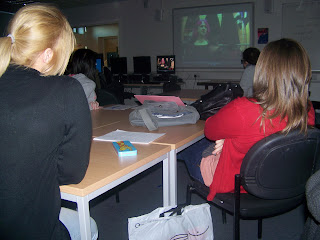
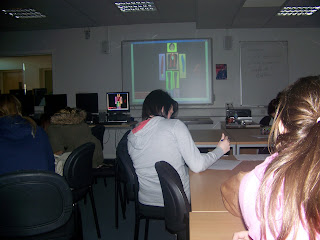
Here is a recording of the script below.
From our questionnaire feedback, we can see that our documentary does appeal to our target audience and the documentary is well suited to channel 4. We can also see that some people thought our interviews were a strength however others thought it was a weakness. Constructive criticism is always helpful as Matt and I can see the things we could improve on if we were to do our documentary again.
I also played our documentary to different people to gain a wider audience feedback and a mixture of opinions. Below are some audience profiles, and they show what they thought and their opinions.
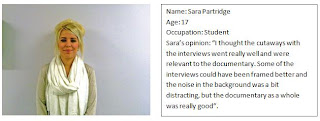
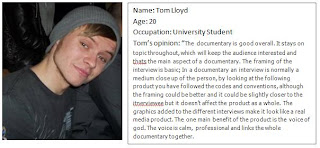
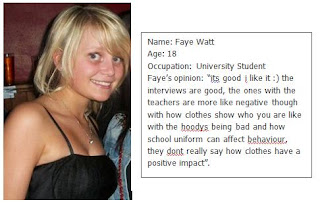
I also gathered audience feedback on the social networking website: Facebook
I am pleased with the audience feedback we received on the social networking website, Facebook. Most of the audience said they enjoyed the interviews, however Tom Lloyd and Joe Akroyd offered some constructive criticism and said that the interviews could have been framed better. Tom also said that the voice of god was good as this linked the whole documentary together and makes it professional.
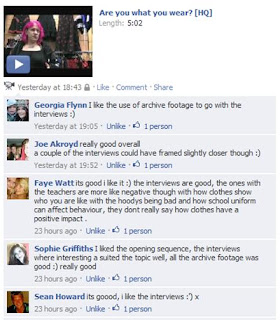
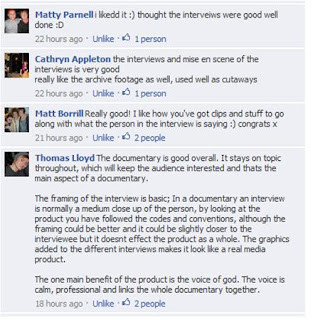
This is a recording of the script below
In my opinion, I was impressed with the title sequence, and also from our audience feedback we had a wide range of answers such as: interesting, eye catching, variety, creative and the music.
A weakness Matt and I had during interviews was background noise and some of our audience picked up on this. During the interview with Adele (shop owner) and Bob (police officer) there was quite a lot of background noise as one interview was inside a shop and the other was outside. If we were to do the interviews again, we would make sure we held the microphone nearer to the interviewee and there wasn’t a lot of background noise.
The scheduling for this documentary was for channel 4 at 9 o’clock and this was a good time as this is a popular time that our audience is watching the TV. The music that was used through the documentary and the radio ad was very upbeat and this played a big part as it attracted our target audience.
Friday, 26 November 2010
Audience Feedback
1. Do you think the camera work and music suit this genre?
Yes-10
No-0
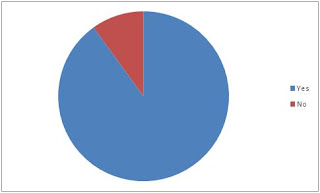
This chart shows that our audience think that the camerawork and the music we used suited the genre of our documentary.
2. Does our documentary flow well?
Yes-10
N0-0
We received positive comments such as ‘cutaways and our voiceover linked well’. And this also shows that our audience think that our documentary flowed well.
3. Is our Documentary Well edited?
Yes-9
No-1
We received feedback saying what we could improve such as ‘more cutaways’. In other feedback, audiences have said that we could have framed the interviews better. But 9 out of 10 people said that our documentary is well edited.
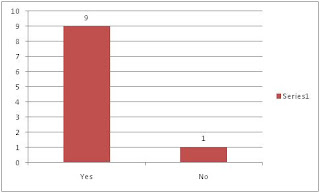
4. What do you think of the title sequence?
Interesting-3
Eyecatching-2
Variety-1
Creative-1
Music-1
Good-2
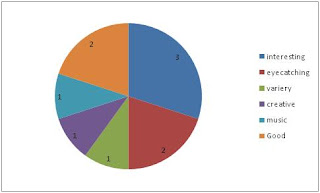
Our feedback for this question shows that most of the audience thought our title sequence was interesting and eyecatching. Few people said the title sequence was variety, and creative and that they enjoyed the music.
5. What do you think of our soundtrack?
Relevant-7
Good-1
Catchy-1
No Opinion-1
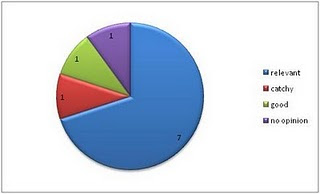
This feedback shows that the target audience thought the soundtrack was relevant to our topic and flowed well with it.
6. Would you watch the whole documentary?
Yes-8
On 4oD-1
Not Sure-1
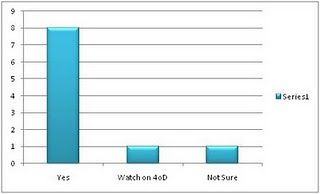
This chart shows that most people would watch the whole of our documentary, however one person said they wasn't sure and another said they would watch it on 4OD.
7. What was your favourite part of the documentary?
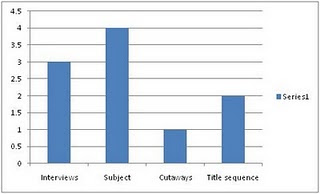
Most people here said that their favourite part of the documentary was the subject. The least favourite part of our documentary were the cutaways.
8. Do you think our documentary appeals to our target audience of 16-24 year olds?
All the 10 people we asked answered yes.
This question shows that all of our focus group think that the documentary appeals to our target audience and so they would watch ot too.
9. Do you think our documentary is suited to channel 4?
Out of the 10 people we asked they all answered yes.
This question shows that all of our focus group agreed that our documentary was well suited to channel 4.
10. How do you think our documentary compares to real documentaries?
10 people said very similar.
This shows that all of our focus group agree that our documeantary compares very well to real documentaries.
11. What are the strengths and weaknesses of our documentary?
Strengths:
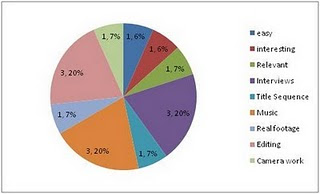
This chart shows that our target audeince thought that the interviews, editing and the music were our strengths during the process of our documentary.
Weaknesses:
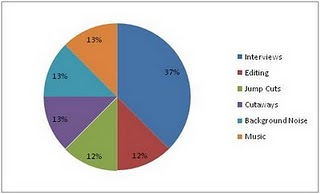
This chart shows that 37% of our focus group thought our interviews were a weakness. However, cutaways, music and background noise all received 30% weakness.
12. Does our radio trailer entice you to watch the documentary?
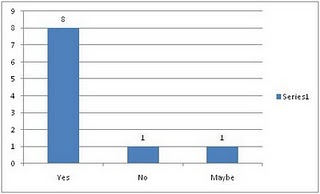
This shows that 8 people out of our focus group thinks the radio trailer entice's you to watch our documentary. 2 people disagreed.
13. Does our print advert draw you in and interest you enough to watch our documentary?
All 10 people answered yes.
All 10 people from our focus group said that the print advert draws you in and interests them enough to watch our documentary.
14. What do you like and dislike about our advertising campaign?
Like:
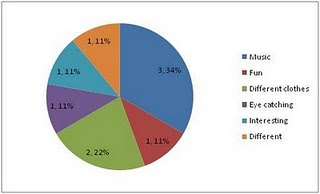
This chart shows that most people liked the music in our advert campaign.Another large percent shows that they enjoyed all the different clothing throughout the documentary.
Dislike:
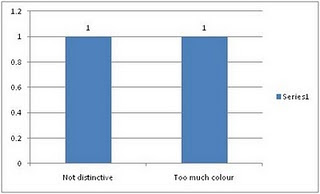
This chart shows that 2 people disliked the too much colour, and also thought that the documentary was not distinctive enough.
Yes-10
No-0

This chart shows that our audience think that the camerawork and the music we used suited the genre of our documentary.
2. Does our documentary flow well?
Yes-10
N0-0
We received positive comments such as ‘cutaways and our voiceover linked well’. And this also shows that our audience think that our documentary flowed well.
3. Is our Documentary Well edited?
Yes-9
No-1
We received feedback saying what we could improve such as ‘more cutaways’. In other feedback, audiences have said that we could have framed the interviews better. But 9 out of 10 people said that our documentary is well edited.

4. What do you think of the title sequence?
Interesting-3
Eyecatching-2
Variety-1
Creative-1
Music-1
Good-2

Our feedback for this question shows that most of the audience thought our title sequence was interesting and eyecatching. Few people said the title sequence was variety, and creative and that they enjoyed the music.
5. What do you think of our soundtrack?
Relevant-7
Good-1
Catchy-1
No Opinion-1

This feedback shows that the target audience thought the soundtrack was relevant to our topic and flowed well with it.
6. Would you watch the whole documentary?
Yes-8
On 4oD-1
Not Sure-1

This chart shows that most people would watch the whole of our documentary, however one person said they wasn't sure and another said they would watch it on 4OD.
7. What was your favourite part of the documentary?

Most people here said that their favourite part of the documentary was the subject. The least favourite part of our documentary were the cutaways.
8. Do you think our documentary appeals to our target audience of 16-24 year olds?
All the 10 people we asked answered yes.
This question shows that all of our focus group think that the documentary appeals to our target audience and so they would watch ot too.
9. Do you think our documentary is suited to channel 4?
Out of the 10 people we asked they all answered yes.
This question shows that all of our focus group agreed that our documentary was well suited to channel 4.
10. How do you think our documentary compares to real documentaries?
10 people said very similar.
This shows that all of our focus group agree that our documeantary compares very well to real documentaries.
11. What are the strengths and weaknesses of our documentary?
Strengths:

This chart shows that our target audeince thought that the interviews, editing and the music were our strengths during the process of our documentary.
Weaknesses:

This chart shows that 37% of our focus group thought our interviews were a weakness. However, cutaways, music and background noise all received 30% weakness.
12. Does our radio trailer entice you to watch the documentary?

This shows that 8 people out of our focus group thinks the radio trailer entice's you to watch our documentary. 2 people disagreed.
13. Does our print advert draw you in and interest you enough to watch our documentary?
All 10 people answered yes.
All 10 people from our focus group said that the print advert draws you in and interests them enough to watch our documentary.
14. What do you like and dislike about our advertising campaign?
Like:

This chart shows that most people liked the music in our advert campaign.Another large percent shows that they enjoyed all the different clothing throughout the documentary.
Dislike:

This chart shows that 2 people disliked the too much colour, and also thought that the documentary was not distinctive enough.
Thursday, 25 November 2010
Subscribe to:
Comments (Atom)



